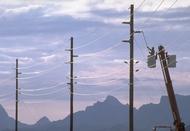The voltage for any electric circuit can come from many different sources. Some common examples are: batteries, power plants, fuel cells.
 |
Power Plant |  |
Flash Light Battery |
 |
Car Battery |  |
Fuel Cell |
When we
plug an appliance into a wall outlet, voltage and current are available
to us. That voltage is actually created in a power plant somewhere else
and then delivered to your house by the power wires that are on poles or
buried underground.

As
a matter of fact, since no current can flow unless there is a voltage
source, we also refer to these sources as current sources. In other
words, without the voltage source, there will be no current flowing.
This makes it a current source instead of a voltage source.
Batteries
create voltage through a chemical process. Power plants generate
electricity from numerous mechanical methods. Some burn coal or gas to
create steam while others use water flowing through a dam on a lake.
There are also nuclear-powered generating power plants. All of these
power-generating systems turn large turbines that turn the shaft on a
generator. All of these sources of electricity convert something called potential energy
to kinetic energy. The potential energy is stored in the fuel, whether
it is coal, gas, uranium, water in a dam, etc. When we utilize these
fuels to generate electricity, they become kinetic energy. We might say that potential energy is waiting to be used while kinetic energy is being used.
In addition to the voltage source, we need to have wires and other components to build an electric circuit. Remember that copper wires are conductors since they can easily conduct the flow of electrons. We may also use resistors or other forms of loads to form a complete circuit. If we did not include resistors in our circuit, there may be too much current flowing to and from our voltage source and we could damage the voltage source.
No comments:
Post a Comment